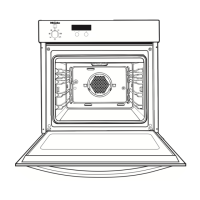
 Loading...
Loading...
Do you have a question about the Miele H 344-2 B and is the answer not in the manual?
Identifies and explains the main components of the oven's control panel.
Details the various parts and features found inside the oven cavity.
Explains features like electronic controls, cooling system, door contact switch, and PerfectClean surfaces.
Details catalytic enamel, the catalyser, and available accessories like baking trays.
Explains the purpose and usage of the roasting filter for specific cooking tasks.
Provides guidance on environmentally responsible disposal of packaging and the old appliance.
Outlines crucial safety precautions for appliance installation, usage, and technical safety.
Details safety advice regarding high temperatures, children, and proper oven operation.
Lists warnings against using plastic containers, heating unopened tins, and placing items on the oven floor.
Covers advice on adding water, oven floor lining, and general cooking safety.
Addresses electrical safety, steam cleaning, alcohol use, and final appliance disposal.
Guides on setting the clock, showing/hiding the time, and changing time settings.
Guides on activating the catalyser and performing the initial oven heating process.
Explains the functions of the programme selector, function dial, input dial, and display.
Details the operation of rotary dials for selecting functions and using the input dial for adjustments.
Provides a chart explaining the meaning of various symbols shown on the oven display.
Outlines the general method for changing oven settings and programmes using the controls.
Describes different oven heating methods like Fan Heat, Auto Roast, Conventional heating, Grill, and Fan Grill.
Instructions on how to select oven settings and programmes for various cooking functions.
Explains the rapid heat-up feature and how to switch it off for specific cooking needs.
Details when and why pre-heating the oven is necessary for optimal cooking results.
Instructions for automatically switching the oven on/off using duration, start time, or end time settings.
Instructions for using the minute minder as a timer, separate from oven functions.
Guides on activating and de-activating system lock and safety lock to prevent unintended use.
Recommended settings, bakeware advice, and specific guidelines for Fan Heat and Conventional baking.
Advice on achieving even results, avoiding over-browning, and handling frozen foods.
A detailed chart providing temperatures, runner positions, and times for various baked goods using Fan Heat.
Recommended settings and methods for roasting, including covered pot and open roasting techniques.
Guidance on calculating roasting time, selecting temperatures, and post-roasting resting.
A chart with temperatures and times for roasting various types of meat and fish using Auto Roast and Conventional heat.
Instructions for pre-heating the grill, setting options, food preparation, and grilling on the rack.
Advice on grilling temperatures, timing, and checking meat doneness.
A chart listing foods, runner positions, temperatures, and times for grilling and fan grilling.
Instructions for using the oven's defrost function, including recommended temperatures and timings for various foods.
General advice for cleaning external surfaces, control panels, and specific warnings for glass and aluminium fronts.
Guidelines for cleaning stainless steel surfaces, controls, and accessories like racks and roasting filters.
Detailed instructions for cleaning and maintaining PerfectClean surfaces to preserve their properties.
Tips for tough soiling, oven sprays, and important notes on preventing surface damage.
Methods for cleaning catalytic enamel surfaces by hand and with high temperatures.
Instructions on how to open the oven door fully for easier cleaning access.
Step-by-step guide on how to carefully dismantle the oven door for cleaning between panes.
Instructions on how to securely refit the oven door and lock the clamps.
Procedures for removing oven runners and lowering the upper heating element for cleaning.
Steps to remove catalytic back panel, side liners, and roof liner for cleaning.
Troubleshooting guide for issues like no heat, lighting problems, and showroom mode activation.
Addresses problems with uncooked food, uneven browning, and incorrect cooking times.
Explains rust-like spots on catalytic surfaces and common error codes displayed by the oven.
Information on contacting Miele for service and support if faults cannot be remedied by the user.
Describes optional accessories like telescopic carriages, runners, and handles for enhanced oven functionality.
Details accessories such as pizza pans, baking stones, gourmet dishes, and catalytic liners.
Covers electrical connection requirements, safety regulations, and fuse ratings for UK and ZA.
Details electrical connection specifications and safety for Australia and New Zealand.
Step-by-step instructions for installing the oven into a housing unit, including electrical connection and securing.